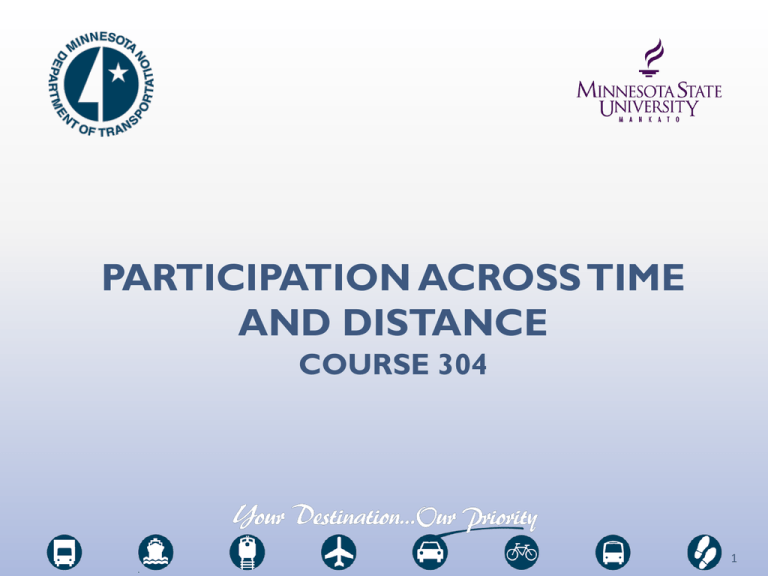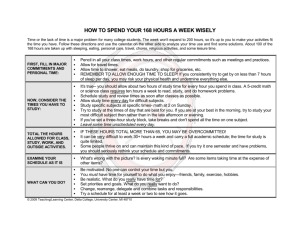PARTICIPATION ACROSS TIME AND DISTANCE COURSE 304 1
advertisement

PARTICIPATION ACROSS TIME AND DISTANCE COURSE 304 1 The Tools We Will Explore Today Challenges of time and distance to public participation Strategies to address challenges and minimize impact 2 Challenges of Time and Distance 3 Challenges of Time and Distance What is ‘Time and Distance’? Some projects last for many years. Therefore the process of public participation may loose its focus and it may be difficult to engage the public over a long period of time. Some projects expands over tens of miles. So the citizens living in distant may have difficulty in public participation. Moreover, a project can have different impact on different communities 4 Challenges of Time and Distance Elements of effective participation over time and distance are Ownership: Assign responsibility for managing the engagement process Information: Conspicuous. Sufficient, and in-line with objectives Participation: Identify all stakeholders in project Maintain commitments: Manage attention and motivation as the project cycles through stages 5 Challenges of Time and Distance Ownership responsibility Maintain commitments Initiative Information Participation 6 Challenges of Time and Distance Ownership Responsibility Lack of ownership responsibility and lack of contact with people results in frustration Assign ownership for participation throughout the life of an initiative Initiative Readiness Issues, Interest & Influences Discovery Selection of Engagement Level Integrate Participation & Decision Making Process Design, Implementation & Evaluate Refer to HEV Module 102 ‘5 Steps of Planning’ 7 Challenges of Time and Distance Information Information should have following characteristics Be available in multiple forms Match user skills Be clear of message Reflect cultural needs Be language appropriate Occur with a pattern of regularity 8 Challenges of Time and Distance Participation over time- Participation level may become dormant during periods of inactivity Probability of changing participants Dramatic changes in context may occur Participants become distant from each other’s perspective Maintain contact, as well as establishing new contacts in challenging 9 Challenges of Time and Distance Participation over distance- Participation level may mirror fluctuation of those in closer proximity Probability remain fairly constant Context typically reflects that of the project as whole Participants are usually distanced from other perspectives Participants may have unique interpretation of purpose & need 10 Challenges of Time and Distance Maintaining Commitments Commitments must be made with clear understanding of the relationship between evolving context and potential commitment shifts Commitments must be documented Documents updates should be communicated as committed 11 Techniques for Overcoming Time and Distance Techniques to overcome challenges of time and distance Interactive television Teleconferencing Interactive displays and kiosks Transportation fairs Games and contests Project website 12 Techniques for Overcoming Time and Distance Techniques to overcome challenges of time and distance (cont’d) Hotlines Drop-in center Site visits Refer to Module 301 for more information on these techniques 13 The Tools We Explored Today Challenges of time and distance to public participation Strategies to address challenges and minimize impact 14 Sources and Resources US Department of Transportation Public Involvement Techniques for Transportation Decision Making http://www.fhwa.dot.gov/planning/public_involvement/publications/techniques /chapter00.cfm Smita Rakshit for the Urban and Regional Studies Institute at Minnesota State University, Mankato http://sbs.mnsu.edu/ursi/ 15




